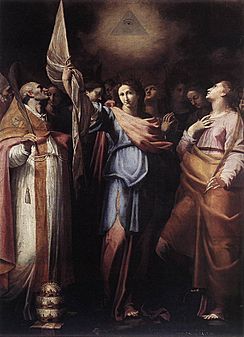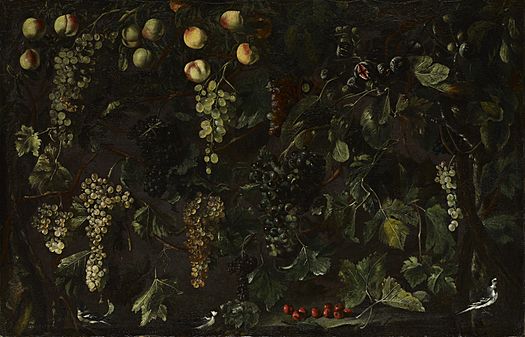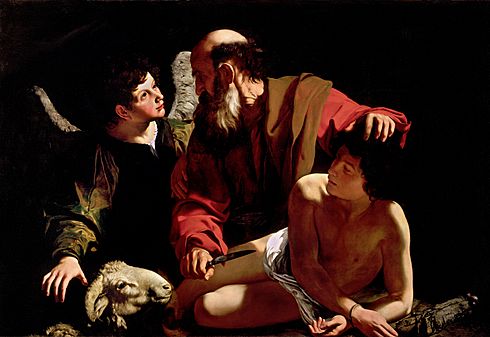Bartolomeo Cavarozzi facts for kids
Bartolomeo Cavarozzi (born 1587, died 1625) was an Italian painter from the Baroque time. He was known for following the style of a famous artist named Caravaggio. This style is often called "Caravaggism."
Cavarozzi's paintings have become much more admired by art experts in recent years. He trained with Giovanni Battista Crescenzi in Rome. Later, he traveled to Spain with his teacher. There, he became well-known and helped spread the "Caravaggism" style. After a few years, he returned to Italy. Most of his surviving paintings show scenes from the Bible or are "still-life" paintings. Still-life paintings show objects like fruit or flowers.
Biography
Bartolomeo Cavarozzi was born on February 15, 1587, in Viterbo, a city in central Italy. He likely moved to Rome when he was a child. There, he started his art training.
His earliest known painting is Santa Ursula and his companions with Pope Ciríaco and Santa Catalina de Alejandría (1608). This painting shows the influence of another artist, Cristofano Roncalli.
Before 1617, Bartolomeo Cavarozzi lived and worked in the palace of Giovanni Battista Crescenzi. Crescenzi was a nobleman, painter, and architect in Rome. He had an art school near the Pantheon. At this school, young artists learned to draw from real-life objects. These objects included fruits, vegetables, and animals.
Cavarozzi's still-life paintings are very important. An example is Grape Vines and Fruit, with Three Wagtailsca (around 1615–18). It is now in the Metropolitan Museum of Art in New York. One of his best works is Saint Jerome with Two Angels. The Medici family in Florence bought this painting in 1617.
The training Cavarozzi received helped him paint details like skulls, rosaries, and books. His paintings also show Caravaggio's style. This is clear in how he used light in the Saint Jerome painting.
In 1617, Giovanni Battista Crescenzi traveled to Spain. He went to work on a project there. Crescenzi took Cavarozzi with him to Spain. They worked there for about two years.
The paintings Cavarozzi made in Spain show Caravaggio's style. This means he used realistic figures and strong light and shadow. However, Cavarozzi also developed his own unique style. His figures were often softer and calmer, not as dramatic. The Holy Family with Saint Catherine of Alexandria (1618) is an example from his time in Spain. It is now in the Prado Museum in Madrid.
Some art experts believe Cavarozzi influenced the early works of the Spanish painter Jusepe de Ribera. Ribera would have seen Cavarozzi's art in Italy.
Cavarozzi returned to Rome in 1619. He worked in Rome and his hometown of Viterbo. He painted Saint Isidore for a church in Viterbo. In 1622, his painting Visitation was placed in the Town Hall chapel in Viterbo. He sometimes made copies of his own paintings. Bartolomeo Cavarozzi died in Rome on September 21, 1625. He was only 38 years old.
Other works by Cavarozzi include:
- San Silvestro for the Church of the Confraternity of Jesus.
- St Phillip Apostle for the Church of San Pietro del Castagno.
- St Benedict for the Church of Monasterio della Duchessa.
- Presentation at the Temple for the Church of the College of Doctors.
- A painting for the Calabresi family chapel in the church of Sant'Ignazio.
Gallery
-
Holy Family (around 1617 - 1625) in the Hermitage Museum.
-
Virgin and Child with Angels (around 1620) in the Museum of Fine Arts, Houston.
-
Aminta's Lament (around 1625) in the Louvre.
-
Grape Vines and Fruit, with Three Wagtailsca (around 1615) in the Metropolitan Museum of Art.
-
Mystical Betrothal of Saint Catherine in the Real Academia de Bellas Artes de San Fernando.
Works
- St Ursula and Her Companions with Pope Ciriacus and St Catherine of Alexandria (1608, San Marco, Rome)
- Guardian Angel (Ángel guardián) (Museo Nacional de Bellas Artes, Buenos Aires)
- Aminta's Lament (1614–15, private collection)
- Saint Jerome and the Angels (1617, Palatine Gallery inside Palazzo Pitti, Florence)
- Holy Family (Accademia Albertina, Turin)
- Virgin and Child (Museum of the Duomo di Viterbo)
- Holy Family with Saint Catherine (around 1618, Museo del Prado, Madrid)
- Virgin and Child with Angels (around 1620), oil on canvas, Museum of Fine Arts, Houston
- Virgen con el niño (around 1618, Colegio de Doncellas Nobles, Toledo)
- The Supper at Emmaus (around 1615–25), attributed
- Young Violinist (Louvre, Paris)
- Young Violinist (Parelari Collection, Bergamo)
- Visitation (1622, Palazzo Comunale, Viterbo)
- Saint Cecilia
- Saint Jerome (Palazzo Margherita, Rome), attributed
See also
 In Spanish: Bartolomeo Cavarozzi para niños
In Spanish: Bartolomeo Cavarozzi para niños












